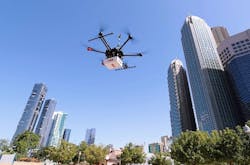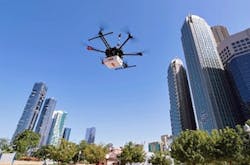The ABB Ability mobile gas-leak detection system can now be mounted on a drone and flown into areas with suspected gas leaks such as along natural gas pipelines. In real time, the 3-kg device (the size of a large shoe box) sends data to operators about methane and ethane levels at parts-per-billion granularity.
The original method of hydrocarbon gas-leak detection was almost comically simplistic—and dangerous to boot. You walk around holding a flame and when it flares, you know you’re on to something.
The newest method, as displayed on the exhibit floor at ABB Customer World this week, is bit more…well…elevated. The ABB Ability mobile gas-leak detection system can now be mounted on a drone and flown into areas with suspected gas leaks such as along natural gas pipelines. In real time, the 3-kg device (the size of a large shoe box) sends data to operators about gas levels at parts-per-billion granularity.
The tool boosts safety for gas-industry personnel, protects industry assets and the environment, and ultimately saves revenue as it speeds the fixes of leaks. Win. Win. Win.
And anything related to drones is inherently cool, a fact proven by the crowds that hovered around the drone display here in Houston.
This new solution also requires fewer man-hours to implement and costs less to operate as it covers wide, hard-to-reach areas. It uses patented cavity-enhanced absorption spectroscopy to detect methane and ethane with a sensitivity more than 1,000 times higher than conventional leak-detection tools. The analyzers extreme sensitivity enables operators to quickly identify potential methane emissions at a greater distance while flying, a feat not practical with other sensor technologies. And to avoid false readings, it can distinguish between biogenic methane, manure and shallow coal and oil deposits, from thermogenic methane from natural gas.
ABB’s analysis software automatically processes the collected methane, ethane, GPS and wind data to create simple reports that can be used to quickly identify areas in the pipeline network with potential leaks. And via the ABB Ability cloud-storage tool, this device enables quick and efficient distribution of data and reports to all stakeholders anywhere in the world. Authorized users can view the progress of flights in real-time as well as review and act on processed leak reports.
Latest evolution in mobile leak-detection
The product represents an evolution in high-sensitivity leak detection. Previous ABB-produced gas-leak-detection tools were handheld or installed in the back of trucks. The modern iteration—carried like an eagle clutching a prized salmon—is an improvement in all respects.
“This is smaller than we’ve ever built. It’s as sensitive as we’ve ever built,” said Douglas Baer, global product-line manager with ABB. “It’s high-speed. Very specific. We can make measurements at 5-Hz—that’s 0.2 seconds per data point. Even though you’re flying around at 20 mph, you’re hitting and reporting data points.”
As for simplicity of use, Baer surmises that the detector is easier to operate than flying the drone itself. “Within minutes you have a plot of all the different concentrations on a map,” boasts Baer, who stresses the cloud-connectivity component, which enables this data can be immediately shared with the full team of, say, first responders during an emergency or pipeline-maintenance crews. “That element enables crews to triage resources—figure out where the biggest leaks are and fix those first.”
These tools are currently being put into play with utilities around the nation. Baer and his team recently conducted a new round of tests in Dubai. And in March 2018, ABB was one of six companies invited by the Environmental Defense Fund and Stanford University to represent the drone sector in the controlled-testing phase of the Mobile Monitoring Challenge, a competition to advance mobile methane-monitoring technologies at oil and natural gas facilities.
The product-line manager envisions, in the very near future, fleets of these devices working in tandem with vehicle-mounted systems, synching all data with all devices and all team members to generate one unified data file with unprecedented insight and accuracy.
Gas leaks don’t stand a chance.
About the Author
Chris McNamara
Chris McNamara

Leaders relevant to this article:

